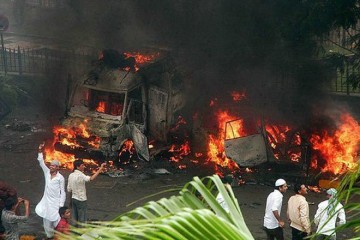This is the time of the year when millions across the globe pray for peace on earth. And no, this is not being said ironically. Surely, as the year winds down to a close, humanity can get together to celebrate the idea of peace, of hope, of compassion, no matter what one’s religious affiliations might be?
But this seems to be a futile wish.
Even as people prepare to celebrate, in various ways, the end of the year, a bloodbath once more engulfs this land. In Sonitpur and Kokrajhar districts of Assam, suspected National Democratic Front of Boroland(S) killed innocent villagers, mostly Adivasis, when they opened fire on Tuesday.
Among the dead were women and young children.
And then the terror, and inevitably, the retaliation. The newspapers have pictures of people fleeing their homes, their possessions in little bundles on their heads. There is grief in their eyes, and horror. Frail men, young and old, arm themselves with nothing more lethal than fragile, primitive bows and arrows, against the modern guns used against them.
The death toll is 72 and rising, and retaliatory attacks are taking place, as expected. In these, and in police firing, seven more have been killed, bringing the total so far to 79.
And so it goes, endlessly. Horror piled on horror.
Around the year, across the globe, there have been numerous deaths at the hands of terrorists. These come to us via the media. Some get worldwide coverage, as well they should. Earlier this month, sending chills up the spines of all were the pictures of the attack on schoolchildren in Peshawar, Pakistan. That was perhaps a new nadir in human depravity, though who knows, even that point might soon be breached.
But some others terror attacks, such as the ones in Kokrajhar and Sonitpur, have hardly been noticed by mainstream media. Even though these assaults are equally horrifying, and deserving of condemnation in the strongest terms. It is not that media coverage will alleviate the sufferings of the survivors. But there is the hope that perhaps, if the rest of the world comes to know of it, there will be awareness of what is going on. And through awareness, perhaps, there will come condemnation, and ultimately, a refusal to tolerate this kind of terrorist attack by the larger communities of the world, in future.
And yes, it is a sorry thing when we weigh “gravity” and “importance” of the horrors around us, to allocate space in our papers and our electronic media. A violent death by a terrorist attack brings trauma and untold grief and misery in its wake, crippling the survivors and scarring them for life. But there is, today, a kind of “terror fatigue” which ensures that only the most gut-wrenching acts of terrorisms make it to the consciousness of the world. The other, numerous deaths by terrorist acts remain in the local media. There seems to be a hierarchy in this matter. This is a very sad, but very true fact of life.
This is a wretched commentary indeed on the state of the world today. Has civilisation reached such a low point that horrific acts must now jostle with each other for media space, each one more terrifying than the last?
We see that body counts matter, even in the space allocated to the news of deaths by terror attacks.
We see that location matters. A large number of deaths in a remote area, considered peripheral by the “mainstream”, merits less space than fewer numbers in a place deemed to be more “central”, therefore more “important”.
We see also that economic status matters. The rich, and the middle class get more media space if they become the victims of these attacks. As for the poor – well, even as pictures of lines of them fleeing their burning homes stream into our drawing rooms, one face merges into the next, one scream of terror begins to sound very much like another.
And that, too, is another aspect of the horrors of the times that we live in.








